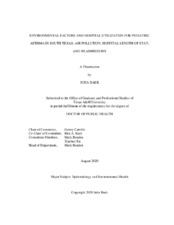| dc.description.abstract | Hospital length of stay (LOS) has been identified as a proxy measure of healthcare expenditures and cost of care in the United States. Hospital readmission is one of the most important asthma-related health outcomes to consider since repeated hospitalizations could lead to a large burden on patients/caregivers, hospitals, and the government with regard to healthcare resources, cost and quality. However, there are limited studies investigating the potentially important associations between ambient air pollution and hospital utilization outcomes, including LOS and hospital readmissions, for pediatric asthma. In addition, few studies have examined factors affecting the high frequency of hospitalization for pediatric asthma.
The first study investigated the association between ambient air pollution and LOS among children with asthma in South Texas. The findings of this study showed that the increased ozone level was significantly associated with prolonged LOS (>2 nights) in the single- and two-pollutant models. The second study examined effects of ambient air pollutants on preventable hospital readmission for pediatric asthma in South Texas. This study found adverse effects of PM2.5 and ozone concentrations on avoidable hospital readmissions among children with asthma. In addition, this study showed that younger age and exposure during the warmer season were associated with the effect of ambient air pollutants.
The final study identified individual and environmental characteristics of children with asthma who had a higher frequency of hospitalizations in a low-income community of South Texas. The results revealed that a modest number of patients with the highest number of hospitalizations accounted for substantial hospital resource utilization. This study also showed that the age of 5-11 years, longer LOS at index admission, initial admission during warm season, and high level of outdoor air pollution in residential neighborhoods present as significant characteristics of pediatric asthma patients with a higher number of hospitalizations in South Texas.
In conclusion, these findings may help health professionals, public health experts, school leaders, and policymakers consider the importance of ambient air pollution on hospital LOS and repeated admissions, among pediatric patients with asthma during education sessions, medical care practice, and policy formulation, emphasizing preventive measures. | en |


